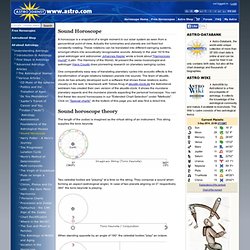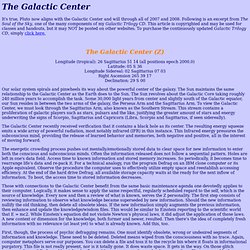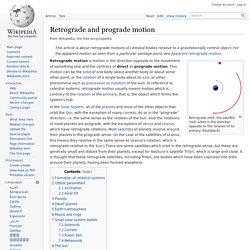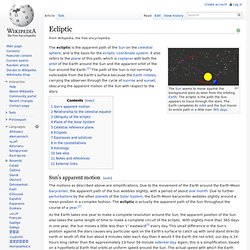

Free Astronomy Teaching Resources. The helical model - our solar system is... - Ophelia Pastrana. Sound Horoscope. A horoscope is a snapshot of a single moment in our solar system as seen from a geocentrical point of view.

Actually the luminaries and planets are not fixed but constantly rotating. These rotations can be translated into different swinging systems, amongst others into acoustically recognisable sounds. The Galactic Center. It's true, Pluto now aligns with the Galactic Center and will through all of 2007 and 2008.

Following is an excerpt from The Soul of the Sky, one of the many components of my Galactic Trilogy CD. This article is copyrighted and may be used for classes and handouts, but it may NOT be posted on other websites. To purchase the continuously updated Galactic Trilogy CD, simply click here. The Galactic Center (Z) Longitude (tropical): 26 Sagittarius 51 14 (all positions epoch 2000.0) Latitude: 05 S 36 Longitude Sidereal: 02 Sagittarius 07 03 Right Ascension 265 39 17 Declination: 29 S 00 Our solar system spirals and pinwheels its way about the powerful center of the galaxy. The Galactic Center recently received verification that it contains a black hole as its center. The energetic crowding process pushes out mentally/emotionally stored data to clear space for new information to enter both the conscious and subconscious minds.
First, though, the process of psychic defragging remains. Futures: World Predictions By Astrologer Richard Nolle. As Above So Below Part 1. Axial tilt. To understand axial tilt, we employ the right-hand rule.

When the fingers of the right hand are curled around in the direction of the planet's rotation, the thumb points in the direction of the north pole. The axial tilt of three planets: Earth, Uranus, and Venus. Here, a vertical line (black) is drawn perpendicular to the plane of each planet's orbit. The angle between this line and the planet's north pole (red) is the tilt. The surrounding arrows (green) show the direction of the planet's rotation. In astronomy, axial tilt, known to astronomers as obliquity, is the angle between an object's rotational axis and its orbital axis, or, equivalently, the angle between its equatorial plane and orbital plane.[1] It differs from orbital inclination.
Introduction[edit] Dragon Precession - DRAGON Labyrinth 2012. Main Page - Astro-Databank, Astrology data and horoscope of 2000. Simplified Scientific Astrology, by Max Heindel, HTML Page 1 of 4. By A Complete Textbook. Retrograde and prograde motion. This article is about retrograde motions of celestial bodies relative to a gravitationally central object.

For the apparent motion as seen from a particular vantage point, see Apparent retrograde motion. Retrograde orbit: the satellite (red) orbits in the direction opposite to the rotation of its primary (blue/black) Formation of celestial systems[edit] When a galaxy or a planetary system forms, its material takes the shape of a disk. Most of the material orbits and rotates in one direction. Orbital parameters[edit] Dragon Precession - DRAGON Labyrinth 2012. Axial precession. Precessional movement of the Earth – the Earth rotates (white arrows) once a day about its axis of rotation (red); this axis itself rotates slowly (white circle), completing a rotation in approximately 26,000 years Earth's precession was historically called the precession of the equinoxes, because the equinoxes moved westward along the ecliptic relative to the fixed stars, opposite to the yearly motion of the Sun along the ecliptic.
This term is still used in non-technical discussions, that is, when detailed mathematics are absent. Historically,[2] Hipparchus has been credited with discovering precession of the equinoxes, although evidence from cuneiform tablets suggest that his statements and mathematics relied heavily on Babylonian astronomical materials that had existed for many centuries prior. The exact dates of his life are not known, but astronomical observations attributed to him by Ptolemy date from 147 BC to 127 BC. Precession nomenclature[edit] Effects[edit] Ecliptic. The Sun seems to move against the background stars as seen from the orbiting Earth.

The ecliptic is the path the Sun appears to trace through the stars. The Earth completes its orbit and the Sun traces its entire path in a little over 365 days. Sun's apparent motion[edit] As the Earth takes one year to make a complete revolution around the Sun, the apparent position of the Sun also takes the same length of time to make a complete circuit of the ecliptic. With slightly more than 365 days in one year, the Sun moves a little less than 1° eastward[3] every day.
Relationship to the celestial equator[edit] Once again, this is a simplification.